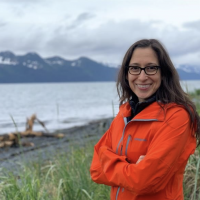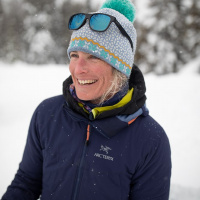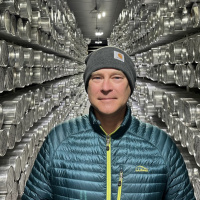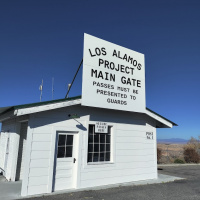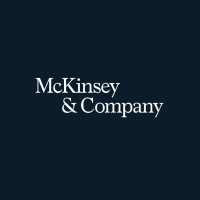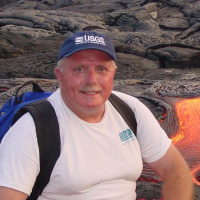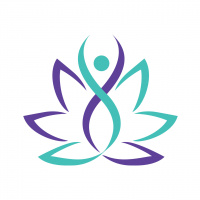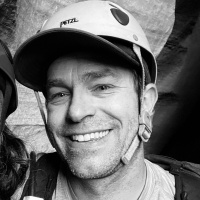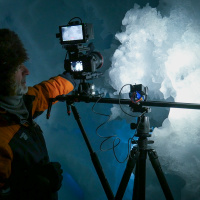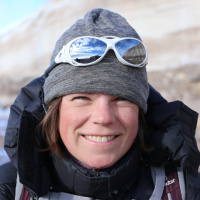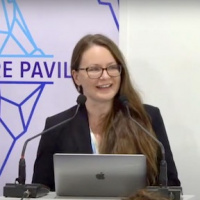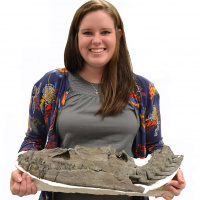Dr. Carlo guides clients to develop a vision for their climate change and Arctic priorities and build momentum to achieve their goals. She has worked across political divides for state senators, ambassadors, and governors on issues of Arctic governance. Her true passions are working with organizations that support climate change equity, and the well-being of Arctic residents and Indigenous peoples. Dr. Carlo’s recent work focuses on driving transformative change in the finance sector to support Indigenous-led climate solutions in the Arctic and beyond. In April 2022, President Biden appointed Dr. Carlo to serve as an academic member on the U.S. Arctic Research Commission, an independent federal agency that advises the president and Congress on domestic and international Arctic research. Dr. Carlo received a Ph.D. in neuroscience from University of California San Diego and a B.S. in psychology from University of Alaska Fairbanks.
Briefly describe your day-to-day work life
I am the founder and CEO of CNC North Consulting. My clients range from federal government entities that support Arctic research to nonprofit organizations working on solutions to the climate crisis. I also write opinion pieces for leading news outlets and in partnership with academic organizations.
As an independent consultant, I have a lot of flexibility in structuring my day. My favorite parts of my day are when I have project-specific meetings—whether in-person or virtually—and get to work with clients to design visions and goals, work through issues, and discuss strategies to bring our vision to reality. Additionally, I spend time preparing presentations for events, managing projects, and following up on requests or inquiries about future work. Each week, I always reserve time for deeper thinking, research, and writing.
What were the best parts or the most challenging parts of transitioning into your current position from your academic experiences (undergraduate, graduate school, postdoc, professional in academia, etc)?
I left academia about 12 years ago after earning a Ph.D. in neuroscience and a brief postdoc. My academic work focused on what makes us human and in particular how the brain region responsible for our flight-or-fight response has changed across species. I took a leave of absence from my postdoc during the 2010 legislative session for a fellowship that places Alaska Native fellows in offices of rural Alaska legislators. This was a significant change for me, and drove my pivot to the Arctic. My focus is now on policy that directly impacts the communities that call the Arctic home. My passion to support the health and wellbeing of Indigenous Peoples drives everything that I’ve focused on during my career.
After I left my postdoc, I was a AAAS Science & Technology Policy fellow at the National Science Foundation. Toward the end of my fellowship, my network began asking whether I offered consulting services. I’ll be honest: I was not previously aware of how consulting worked or that this path was an option. I started doing business as a sole proprietor, which seemed the most straightforward for my situation and given my state’s requirements. In those early days I mainly worked with former colleagues on a part-time basis. I have “paused” my consulting company at various times to take full time positions with the Alaska State Legislature, U.S. Department of State, and Executive Office of the Alaska Governor. In 2019, I made a conscious decision to operate CNC North Consulting LLC as my primary focus, worked through a vision for the services we offer, and launched a new website. Business grew from there but so far the company has remained small, though I am considering scaling up for greater impact and with an eye toward training the next generation.
A key thing I learned early on was that pivoting is hard, scary even. Doing something new can be both exciting and carry some uncertainty—consultants have inconsistent income flows and have to juggle the administrative side of running a business, 401Ks, healthcare, and so on. But it is worth it to me because I get to explore different interests and ways of working. The most challenging part for me during the transition to a working world outside academia was to become comfortable with forecasts and flexibility.
What are some transferable skills from your academic preparation or time in academia?
I regularly use the lens of science—curiosity, interest in learning something new, and understanding something deeply— in my day-to-day work. However, I do not use the technical neuroscience that I spent years in graduate school studying—and that’s OK. Now, as more of a generalist I focus on systems and how different components are linked or connected.
I also spent time in grad school as a mentor to younger students (high school and college-level), serving on campus wide committees, and supporting outreach programs about neuroscience at local schools on the U.S.-Mexico border. These experiences helped shape my interests outside of academia and taught me the importance of communicating science to a broader audience. I also learned lots of other skills that are transferable: how to project manage, how to lead (or not) a group toward a goal, how to work with (or not) colleagues, how to synthesize complex information, and how to communicate that information to academic and non-academic audiences. These are all things that will also be useful in other careers and places.
Graduate school also taught me a lot of things that I had to unlearn later. When I left academia, I had to remember that it was okay to be wrong, to not know something, or to ask for help. I had to remember that journal articles aren’t the only way to measure success. And I had to remember that working together is sometimes better than being an exceptional individual, and that “discovery” is secondary (or even lower on the list) to building trust, working together, and forming respectful relationships. These are things that my Indigenous community taught me and I’d like to center this type of learning and values in academia and other spaces.
What is the most surprising part of your current position?
When I transitioned away from academia, I was most surprised to learn I thrive in environments that are fast paced and require connection and relationships with other people. I enjoy working on policy that positively impacts people and the planet in the near future.
As a neuroscientist, I was studying comparative neuroanatomy—which is important science but was difficult for me to connect to the issues facing my community and the Arctic. My first step outside academia was to a fast-paced legislative environment back in Alaska. It was a completely different tempo than I was used to working in, yet I could feel the impact my work was making. It was there that I found my footing and felt more grounded.
What advice would you give to someone interested in a non-academic or alternative academic career?
Reflect back on where you have spent time or gained energy during the last three to four years. There might be patterns there that can give you a clue to what you might want to focus on. Look for resources or opportunities locally to become involved in things that are beyond your academic area. Seek out people who have a career that you want to know more about or might be interested in.
How is the workplace culture and work/life balance at your current position?
I have some control over my work/life balance since I manage the company workload and schedule. I prioritize taking care of self and family, including unplugging from work when on personal leave. There are, of course, times when weeks are overly scheduled and I work long hours to meet a deadline, but I’m able to keep that from being the norm.
I try to find a stable balance of my time so that I can meet my commitments with a high quality of work and dedicated attention. I generally don’t have a large number of clients; instead I prioritize long-term relationships. This all comes into consideration when I’m evaluating potential clients. I also look for alignment with my company’s mission and goals to elevate community-driven solutions to climate change. I might initially use smaller scale project work with a client to learn more about the working relationships before building to a longer-term, ongoing role. Regardless, I aim to use clear expectations, time commitments, and contract agreements to ensure both parties are on the same page. I like to schedule regular meetings with the client at a pace that ensures the work can progress in a reasonable way to meet deadlines. As always, good communication is essential for success in my line of work.
What opportunities are available for polar scientists with bachelors, masters, or PhD? For example, how important do you think a PhD is for landing a job outside academia?
I’ve worked in policy at the state-wide level and the national level. In my experience there were very few Ph.D. trained staff working in the state legislature. The AAAS Science & Technology Policy Fellowship ensures that there are scientists and engineers serving as congressional staff and in the executive branch. Federal program managers and principal investigators at federal agencies generally do have terminal graduate degrees. There are also other interesting careers that intersect in science policy spaces—science writing, science communications, and science education and outreach. I don’t think a PhD is necessary. However, many that work at the science and policy interface have some post-baccalaureate training (e.g., a masters degree).
Dr. Kelly Singel maintains a list of science policy fellowships. The organization Engineers & Scientists Acting Locally (ESAL) also maintains a database of local engagement opportunities in the US.
How did you find your current job? Do you have advice on searching for jobs and networking for job opportunities?
I created my own job. Consulting is something I actually often recommend to others, even starting out with something small as a side gig/hustle. It is relatively easy to set up a sole proprietorship or an LLC. I encourage people to do this because doing so can help create boundaries around what falls within their full-time job vs. consulting work. I think it’s incredibly helpful to explore skills that you enjoy offering to others. For example, perhaps you enjoy facilitating discussions that build group dynamics and this is something you do within your lab group. What if others outside your department or university ask for those services? This is potentially something that could squarely fall outside your regular job description and instead be something that you provide as a consultant for a fee.
Your networks and relationships are incredibly valuable for lots of reasons but also as a consultant. Professional recommendations and word of mouth can bring business your way. It is also important to communicate what consulting services you offer and if you have availability in your schedule or are booking several months out. I recommend sharing what services you offer with both prospective clients (your network) and also with other consultants. I talk with many prospective clients and if a project is not the right fit for me, I am more than happy to pass on recommendations for other consultants who might meet the needs required. I find myself always in need of good recommendations for facilitation services by those experienced in cross-cultural communications and in research, science communication beyond academia, and training in different ways of knowing. CNC North Consulting sometimes needs additional expertise so I usually draw from my consulting network to subcontract for those services, e.g. communications, research and analysis, etc.
Never underestimate the power of a web presence. When I restarted my consulting company in 2019, initially I did not have a website. I figured people who knew me would reach out, which they did. However, it made a world of difference to have a virtual landing page where people could learn about me, my previous work, and what services I offer. It is better to make things quickly accessible for potential clients—a webpage with contact information can easily be shared or forwarded and there should be a low barrier to scheduling an initial consultation, in my experience.
How creative can you be at work?
Being creative is important to me. I think of creativity as being able to follow the questions that I find intriguing and to come up with new solutions to problems that people seem stuck on.
I purposefully structure my work week to make space for flexible time dedicated to deeper thinking, reading, and design development. Consulting allows me to lead with my values and to work on different interesting projects. I’ve found it useful to know what I don’t enjoy doing and what does not give me energy. For example, I don’t offer services related to meeting hosting or coordination; these types of projects have lots of moving parts and details. Sometimes I overly focus on details, drain my energy, and then don’t have enough brain space left to shape overarching goals or strategies.
Many of the projects I work on require me to be creative—with a focus on solving the big problems around climate change—and this is by design. I am exploring ways to use financing in innovative ways through a climate response financing initiative that supports Indigenous-led solutions to climate change. I am also thinking about how to build movements of people who are willing to flip the script and see things from a different point of view. I call this action an Arctic 180: where can we flip our perspective to drive major change for the better? For example, Stockholm, Berlin, Hong Kong, and Tokyo have all stopped designing streets for cars and focused on pedestrian and cyclist safety. They are now the top-rated cities in the world for traffic safety. How can we apply similar 180s to the Arctic and the climate?
Is there anything else that you want to share?
You can learn more about my work on my website and connect with me on LinkedIn.
